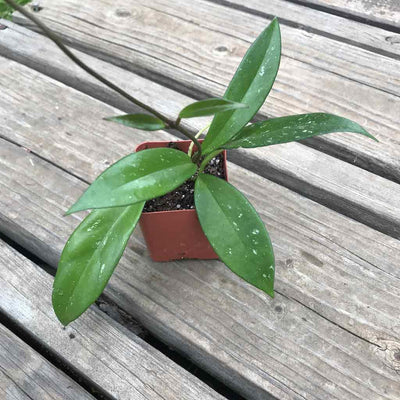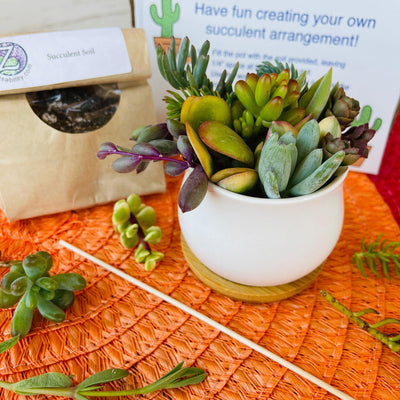Shipping policy
Live succulent plant orders ship within 3 business day of purchase, with most orders shipping in 1-2 days.
Succulent arrangements, Hoya plants, and plant cuttings ship within 3 business days of purchase.
Please note: Weather, plant size, and time of year can effect the amount of time to ship. On occasion potted or large plants can take up to 5 days. You will be notified via email of any delays.
We are happy to expedite when possible, please contact us at hello@zensability.com with your request.
Our standard shipping days are Monday through Friday.
If you prefer to avoid Thursday/Friday shipping, please contact us to make the request.
Note: Shipping times can vary depending on plant size, weather and season. Please allow 1-5 business days to process your order.
If you have any issues with the condition of your plant, please contact us within 48 hours with pictures of the plant and box.
Bare root means that most of the soil is removed from around the roots before shipping. This is for both the weight and health of the plants during shipping. Most succulents ship bare root.
Semi-bare root means that some soil is wrapped around the roots before shipping. Most Hoya ship semi-bare root.
Very carefully! In most cases, we individually wrap each plant in tissue paper for safe travel (and so they are fun to unwrap).
We hear from customers repeatedly that they are impressed with the condition of their plants on arrival.
If you have any issues with your plants upon arrival, please contact us with your order number and pictures of the areas of concern within 48 hours.
Yes! We offer a guarantee on all live plants when you:
1. Qualify for free shipping or select Priority Mail shipping.
2. Add a heat pack for cold climates November - March.
3. Contact us, with pictures included, within 48 hours of plant arrival.
We offer shipping to the United States, Guam, and Puerto Rico at this time. We hope to offer international shipping in the near future.
HappyZense Guarantee
Your satisfaction is guaranteed when you select Priority Mail during shipping or qualify for Free Shipping (orders $35+)
To qualify for the HappyZense guarantee:
1. Spend $35 or more on your order or select Priority Mail service when placing your order.
Orders that ship free ship via USPS Priority Mail.
2. Add a heat pack for cold climates November - March.
3. Contact us (hello@zensability.com) within 48 hours of plant arrival, including pictures, if you have any concerns about health or excess damage
4. Pictures must be included.
You can reach us anytime at hello@zensability.com with any concerns about your plants or shipments.
Please rest assured that many customers select First Class Mail with the confidence that the plants will arrive safe. This is due to the way we wrap each plant individually and also include extra paper in the box for padding and insulation.
First Class Mail can take 7-10 days and is not guaranteed, but is generally okay for succulent orders Spring-Fall, especially within the Western United States.
We do recommend Priority Mail service for all house plants and Hoya shipments year-round and for all succulent shipments during the winter or extended hot/cold periods.
If your plant was
extremely damaged during shipping or arrives unhealthy, please contact us within 48 hours of plant arrival and send pics
of all of the following:
- the damaged plant/areas of concern
- the box condition
We will make it right and make sure you are happy.
*You must qualify for Free Shipping or select Priority Mail as the shipping method to qualify for the HappyZense guarantee (refund or replacement of any damaged or unhealthy plant, owner's discretion).
*Any live plant that has been in a dark box for a few days is likely in shock and need of some TLC.
- The color might change.
- Thin Hoya leaves might look wilted.
- Leaves and branches can become damaged during shipping or just from the plant going into shock.
This does not effect the health of the plant. In 99% of these cases will bounce back and thrive. Care, replanting, and acclimation instructions are included in every box.
Succulent Plant Care FAQs
You will need a well-draining soil for your new succulent plant. We recommend a cactus & succulent specific soil, but if you are unable to locate one, you can create your own mix.
To create your own succulent soil, you will need potting soil and either perlite, pumice, or vermiculite. Any one of these additives helps to aerate the soil and increase the drainage. This is important to keep the roots of your succulents from getting too soggy and potentially rotting.
An ideal mix is 3 parts potting soil to 1 part perlite or other additive. If you live in a very humid location, you can add a bit more perlite.
Don't add a layer of rock or gravel to the bottom of your pots.
You will not want to add rock, gravel, or stones to the bottom of the pot. Contrary to popular belief, this causes water to pool at the bottom of the pot. It impedes drainage instead of aids it.
There are two keys to watering succulent plants:
1. Use well-draining soil and a pot with drainage.
2. Only water when soil is dry to the touch.
Succulents can handle under-watering a lot better than they can handle over-watering.
Overwatering is the number one cause of succulent death. You can often wait until succulent leaves start to look deflated or shriveled before watering.
Succulent cuttings can be propagated in the following way:
1. Let the cut end of the succulent plant callous, or dry, completely.
2. Stick the cut end deep enough in well-draining soil for it to be stable. Rosettes should be resting on the soil.
3. Keep out of direct sun for a week and then slowly acclimate to partial sun exposure.
3. Wait at least two weeks before watering. The plants won't need water until roots start to shoot out.
4. Wait until the soil is completely dry to the touch before watering again.
Succulent leaves on most succulent plants naturally dry up as the plant matures.
So, no, you are not necessarily doing something wrong if the bottom leaves on your succulent tend to dry up and fall off. It's part of succulent's natural growth cycle to lose their bottom leaves. This is especially true for Echeveria, Aloe, Haworthia, and Agave, but occurs in most succulents as they grow.
To ensure that your succulent is not losing an abnormal amount of leaves, make sure that you are watering sufficiently. The best rule of thumb is to water when the soil gets dry to the touch.
For additional tips on succulent care, see our blog post 'How to care for your succulents'.
Hoya Plant Care FAQs
Hoya plants are relatively easy-care house plants. Here are answers to care questions we often receive about Hoya:
Hoya thrive in very well-draining soil for Hoya. Hoya are epiphytic plants, which means they get a lot of moisture and nutrients from the air through their leaves.
Use a well-draining soil and provide humidity (humidifier or mist from a spray bottle) between each watering. This will keep your Hoya from getting over-watered and rotting due to soggy roots.
You can use a pre-made succulent and cactus soil with some added perlite to increase the drainage. Many people like to use a mix of orchid bark, potting soil and lyca for their Hoya.
If you do not have access to a succulent and cactus mix you can make your own by mixing potting soil with perlite, pumice OR vermiculite. You can usually find at least one of these at home improvement / garden stores. This additive will make the potting soil a well-draining soil which will enable your new Hoya plant to thrive.
Your new Hoya plant should be planted in well-draining soil.
When you first pot your hoya, wait a day or two, and then place the pot in a shallow dish of water. Leave it there until the top soil is damp. This saturates the soil and gives the plant a good drink. Watering from the bottom up will avoid damaging the newly planted roots.
Water again only when the top soil gets dry to the touch.
Provide humidity
Hoya get a lot of moisture from the air, so it's a good idea to provide some extra humidity for your Hoya plant between each watering.
You can mist them every couple of days if you are not in an already humid environment. It is better to mist the hoya and wait until the top soil is dry to the touch, than to risk overwatering the plant.
Hoya cuttings can be propagated in any of the following three ways:
1. Submerge the cut end in water. Keep out of direct sunlight and refresh water occasionally as needed. Replant when at least 1" of roots have grown.
2. Stick the calloused ends of the Hoya cuttings in well-draining soil. Keep out of direct sunlight and do not water for a couple of weeks. Once the plants start to shoot out roots, you can start a regular watering cycle.
3. Submerge the cut end of the Hoya plant in a mixture of water and lyca (clay pebbles). Refresh the water occasionally and replant, along with any clinging pebbles, once at least 1" of roots have grown.
Method #3 seems to be the fastest in our experience, but all three methods work.







